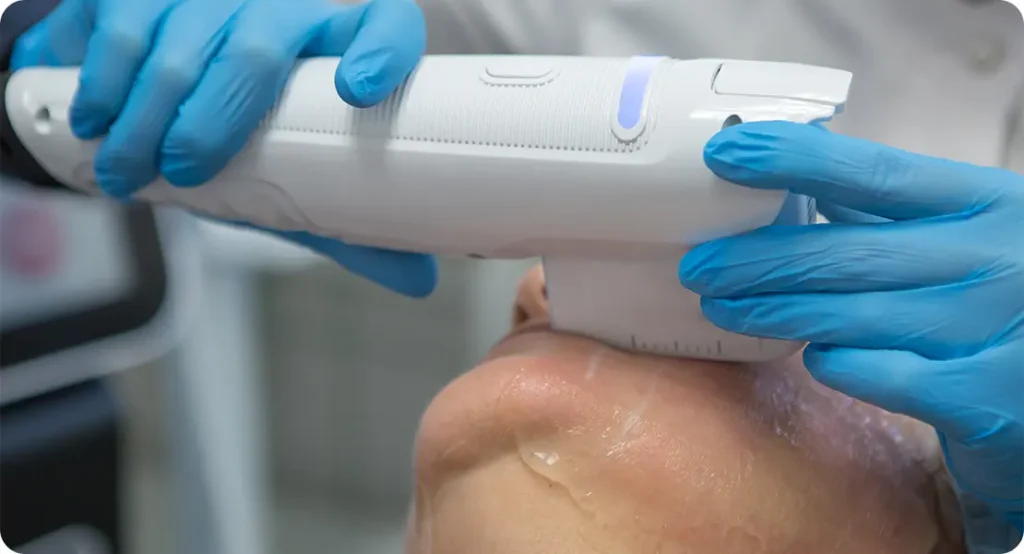Laser treatments are an increasingly popular solution for improving skin texture, reducing fine lines, treating sun damage, and managing acne scars. Among the most commonly discussed options are Fraxel laser treatment and CO2 laser resurfacing.
Many people confuse these two treatments, assuming they provide the same results or are interchangeable. While both are effective, they differ in depth, downtime, recovery, and the types of skin concerns they address.
In this guide, I’ll break down the key differences between Fraxel and CO2 laser treatments, helping you understand which option may be best for your skin and goals. By the end, you’ll be equipped to make an informed decision with input from your dermatologist.
Understanding Fraxel Laser

Fraxel is a type of fractional laser designed to improve your skin by targeting it in tiny, precise columns. While it sounds technical, the idea is simple: it creates microscopic “micro-injuries” in your skin, which may seem intimidating at first but these tiny wounds actually trigger your body’s natural healing process. This encourages collagen production, helping your skin regenerate and repair itself over time.
Here’s what you need to know about Fraxel:
- Non-ablative or fractional ablative technology: Fraxel targets only the areas that need treatment instead of removing your entire skin surface. This makes the process gentler and reduces the chances of irritation.
- Minimal downtime: After treatment, you might notice mild redness, flaking, or a sunburn-like feeling. The good news is that these usually settle within a few days, allowing you to get back to your normal routine quickly.
- Gradual, natural results: Collagen production takes time, so your improvements will appear slowly over weeks or even months. This means your skin will look naturally refreshed rather than suddenly “done,” giving you a more authentic glow.
Fraxel can help if you’re looking to improve:
- Fine lines and wrinkles: Smooth out those early signs of ageing and regain a more youthful appearance.
- Acne scars or pitted scars: Fraxel works beneath the surface to soften scars and improve texture.
- Uneven skin tone and sun damage: If your skin looks blotchy or sun-affected, Fraxel can help even it out.
- Mild pigmentation issues: It can target darker patches, helping your skin tone look more uniform.
One of the best things about Fraxel is how versatile it is. It’s suitable for most skin types, which means you don’t have to worry about being limited by your complexion. Plus, if you’re someone who wants visible improvements without taking a long break from your daily life, Fraxel could be the perfect fit for you.
By choosing Fraxel, you’re not just addressing one issue you’re encouraging your skin to heal and rejuvenate itself naturally, leaving it looking healthier, smoother, and more radiant over time.
Understanding CO2 Laser

CO2 laser resurfacing is a more intensive skin treatment that goes deeper than other lasers like Fraxel. It works by removing the outer layers of your skin (the epidermis) while heating the underlying layers (the dermis) to stimulate collagen growth. This helps your skin repair itself, tighten, and look more youthful over time.
Here’s what you should know about CO2 laser:
- Ablative technology: Unlike gentler lasers, CO2 removes the surface layer of your skin, giving you deeper resurfacing for more noticeable results.
- Longer downtime: After treatment, you can expect redness, swelling, and peeling for one to two weeks. It’s more of a commitment, but the results are worth it if you’re looking for dramatic improvement.
- Rapid, noticeable results: Because it works deeply, you’ll see faster improvements in your skin texture, fine lines, and even deep wrinkles compared to gentler lasers.
CO2 laser works particularly well if you’re trying to address:
- Deep wrinkles and pronounced facial lines: Smooth out lines that have formed over the years.
- Severe sun damage and age spots: It can help reduce the signs of long-term sun exposure.
- Deep acne scars and texture irregularities: Improve uneven areas and give your skin a smoother finish.
- Skin tightening and overall rejuvenation: The collagen boost helps lift and firm your skin naturally.
Because CO2 laser is more intense, it’s usually recommended for patients who want dramatic results and are willing to accept a longer recovery period. If you’re ready to commit to the process, CO2 laser can transform your skin’s texture and appearance in a way gentler treatments can’t.
Key Differences Between Fraxel and CO2 Laser
Both Fraxel and CO2 lasers can improve your skin texture and boost collagen, but they work in different ways. Here’s what you need to know to choose the right option for you:
Depth of Penetration
- Fraxel: This laser targets your skin in tiny, precise columns, reaching both the surface and deeper layers depending on the settings. It’s perfect if you’re looking to treat mild to moderate issues like fine lines or light scarring.
- CO2 Laser: CO2 goes deeper and actually removes the surface layer of your skin. This makes it better suited if you want to tackle severe wrinkles, pronounced scars, or more advanced sun damage.
Recovery Time
- Fraxel: You’ll usually experience mild redness or flaking for 2–5 days, and you can get back to your normal routine quickly.
- CO2 Laser: Healing takes longer expect 1–2 weeks of peeling and redness. Full recovery, and seeing the best results, may take several months.
Pain and Discomfort
- Fraxel: Most people find it comfortable, with only a mild tingling or warming sensation. A topical numbing cream is often used to make it even easier.
- CO2 Laser: This one is more intense, often needing local or topical anaesthesia. You may also feel some discomfort during the recovery period.
Results Timeline
- Fraxel: You’ll notice gradual improvements as your collagen builds over weeks to months. You may need multiple sessions for the best results.
- CO2 Laser: Because it works more deeply, results are faster. Improvements in skin texture and tightness are usually visible soon after your skin has healed.
Suitability for Skin Types
- Fraxel: Safe for most skin types, including darker tones, when the settings are adjusted correctly.
- CO2 Laser: There’s a higher risk of pigmentation changes in darker skin tones, so it’s important to have this treatment under professional supervision and with careful patient selection.
Which Treatment Is Best for Your Skin Goals?
Deciding between Fraxel and CO2 laser really comes down to what you want to achieve, your skin type, and how much downtime you’re comfortable with. Here’s a quick guide to help you figure out which might suit you best:
Choose Fraxel if:
- You want mild to moderate improvements in your skin
- You prefer minimal downtime and a quicker recovery
- You have sensitive or darker skin
- You’re targeting fine lines, mild scars, or early signs of sun damage
Choose CO2 Laser if:
- You’re after dramatic, more noticeable results
- You can manage longer downtime for healing
- You’re treating deep wrinkles, severe sun damage, or pronounced scars
- You have lighter skin tones, which lowers the risk of pigmentation issues
The best approach is to consult a dermatologist who can tailor the treatment to your skin type and your personal aesthetic goals. That way, you can feel confident you’re choosing the right option for you and your skin.
Combining Fraxel and CO2 Treatments
In some cases, your dermatologist might suggest combining Fraxel and CO2 laser treatments to get the best of both worlds. Here’s how it typically works:
– Start with Fraxel: You can begin with a few Fraxel sessions to achieve gradual improvements with minimal downtime. This helps you refresh your skin and address mild concerns without a big recovery period.
– Follow with CO2 Laser: Once your skin has responded to Fraxel, a CO2 session can be used for deeper resurfacing and more dramatic correction, targeting issues like deep wrinkles or pronounced scars.
By combining these treatments, you get incremental improvements over time while keeping downtime manageable and reducing the risks associated with more intensive procedures. It’s a flexible approach that lets you personalise your treatment plan according to your skin’s needs and your lifestyle.
Recovery and Aftercare
How your skin recovers depends on which laser treatment you choose. Here’s what you can expect and how to take care of your skin:
Fraxel Recovery:
- You might notice mild redness and some flaking for 2–5 days. This is normal and part of your skin’s healing process.
- Avoid direct sunlight and make sure to use a broad-spectrum sunscreen to protect your skin.
- Apply any soothing creams or ointments recommended by your dermatologist to keep your skin comfortable and hydrated.
CO2 Laser Recovery:
- Expect redness, swelling, and peeling for 1–2 weeks. Healing takes longer because this treatment is more intensive.
- Keep your skin well moisturised and avoid sun exposure to prevent irritation or pigmentation changes.
- Follow all post-treatment care instructions carefully this helps reduce the risk of infection and ensures the best possible results.
No matter which laser you choose, professional supervision and following aftercare instructions are key to a smooth recovery and long-lasting results. Taking the right steps now will help your skin heal beautifully and maintain its refreshed, rejuvenated look.
Risks and Considerations
While both Fraxel and CO2 lasers are generally considered safe when performed by qualified professionals, it’s important to understand the potential risks and side effects associated with each treatment.
Fraxel Risks:
- Temporary redness and swelling: Most patients experience mild redness and swelling immediately after treatment, typically resolving within a few days.
- Flaking and peeling: Treated skin may flake or peel as part of the natural healing process.
- Hyperpigmentation or hypopigmentation: Rarely, the skin may develop darker or lighter patches, especially in individuals with darker skin tones.
- Infection: Though uncommon, there is a slight risk of bacterial or viral infections, such as cold sores, if preventive measures are not taken.
- Sensitivity: Skin may feel sensitive to sunlight or topical products for several weeks post-treatment.
CO2 Laser Risks:
- Extended redness and swelling: CO2 laser treatments are more aggressive, often resulting in redness and swelling that can last 1–2 weeks or longer.
- Scarring: Improper technique or post-treatment care can increase the risk of scarring.
- Pigmentation changes: There is a higher likelihood of temporary or permanent hyperpigmentation or hypopigmentation compared to Fraxel.
- Infection: Due to the deeper nature of CO2 laser resurfacing, the risk of bacterial or viral infections is slightly higher.
- Prolonged healing time: Recovery can take longer, requiring diligent aftercare, including sun protection and moisturisation.
Minimising Risks:
- Patient selection: Certain skin types, medical conditions, or medications may increase the risk of complications. A thorough consultation is essential.
- Professional application: Choosing an experienced dermatologist or laser specialist greatly reduces risks.
- Post-treatment care: Following aftercare instructions, such as avoiding sun exposure, using gentle skincare, and keeping the skin hydrated, helps promote safe healing and optimal results.
Both lasers offer excellent results when used correctly, but understanding and preparing for these potential side effects ensures a safer and more satisfying outcome.
FAQs:
1. How do Fraxel and CO2 lasers differ in how they work?
Fraxel and CO2 lasers both aim to improve skin texture and stimulate collagen, but they do so in different ways. Fraxel is a fractional laser that creates microscopic columns of controlled damage in the skin, leaving surrounding areas intact to support rapid healing. This encourages natural collagen production gradually over time. CO2 laser resurfacing, on the other hand, is an ablative treatment that removes the outermost layers of skin while heating the deeper layers to trigger a more intense collagen response. This makes CO2 more suitable for deeper wrinkles, pronounced scars, or severe sun damage, while Fraxel is better for mild to moderate concerns.
2. Which laser treatment is more suitable for sensitive or darker skin tones?
Fraxel is generally considered safer for a wider range of skin types, including sensitive or darker tones, because it targets only fractions of the skin and is less aggressive. CO2 laser carries a higher risk of pigmentation changes, such as dark or light patches, in individuals with darker skin, making careful patient selection and professional supervision crucial for this treatment.
3. How long does recovery take after each treatment?
Recovery time differs between the two lasers due to their intensity. After Fraxel, mild redness and flaking typically last between two and five days, allowing most people to resume their normal routines quickly. CO2 laser involves a more intensive healing process, with redness, swelling, and peeling lasting one to two weeks. Full results may not be visible until several months post-treatment as the skin fully remodels and collagen develops.
4. Are the results of Fraxel and CO2 laser permanent?
Neither treatment halts the natural ageing process, but both offer long-lasting improvements in skin texture, tone, and firmness. Fraxel results tend to be gradual and cumulative, often requiring multiple sessions for optimal effect, while CO2 laser provides more immediate, dramatic results. Maintaining results requires proper skincare, sun protection, and periodic maintenance treatments as recommended by a dermatologist.
5. Is one treatment more painful than the other?
Most patients find Fraxel to be comfortable, often describing it as a mild tingling or warming sensation during treatment. Topical numbing cream can be applied to reduce discomfort further. CO2 laser is more intensive, and local anaesthesia or strong numbing agents are commonly used. Some discomfort may persist during the initial recovery period due to swelling and peeling.
6. Can Fraxel and CO2 laser be combined?
Yes, in some cases dermatologists may recommend a combination approach. A patient might start with Fraxel to gradually improve mild concerns with minimal downtime and later undergo CO2 laser for deeper resurfacing and dramatic correction. This strategy allows incremental improvements while managing recovery time and minimizing risk.
7. What skin concerns are best treated by each laser?
Fraxel is ideal for addressing fine lines, mild acne or pitted scars, uneven skin tone, sun damage, and minor pigmentation issues. CO2 laser, being more aggressive, is better suited for deep wrinkles, severe sun damage, age spots, deep acne scars, and overall skin tightening. The choice depends on the severity of the concern and the desired speed of results.
8. What are the risks associated with these treatments?
Both lasers are generally safe when performed by qualified professionals, but risks do exist. Fraxel may cause temporary redness, mild swelling, flaking, rare pigmentation changes, and occasional infection. CO2 laser has a higher likelihood of prolonged redness, swelling, scarring, pigmentation changes, infection, and extended recovery. Proper patient selection, professional technique, and diligent post-treatment care significantly reduce these risks.
9. How should I care for my skin after laser treatment?
After Fraxel, it is important to keep the skin hydrated, use gentle skincare products, and avoid sun exposure with broad-spectrum sunscreen. For CO2 laser, meticulous aftercare is critical. This includes keeping the skin moisturised, avoiding direct sunlight, and following all instructions provided by the dermatologist to prevent infection and pigmentation issues. Proper aftercare enhances healing and ensures the best possible results.
10. How do I know which treatment is right for me?
Deciding between Fraxel and CO2 laser depends on your skin goals, skin type, and willingness to manage downtime. Fraxel is best for mild to moderate improvements with minimal recovery, whereas CO2 laser is suited for dramatic results in patients prepared for longer healing. Consulting a qualified dermatologist is essential; they can assess your skin, recommend the most appropriate treatment, and tailor a plan to achieve safe and effective outcomes.
Final Thoughts: Choosing Between Fraxel and CO2 Laser
Both Fraxel and CO2 lasers are highly effective for improving skin texture, reducing fine lines, treating scars, and rejuvenating the skin. However, it’s important to remember that not every treatment is suitable for everyone. Factors such as skin type, the severity of skin concerns, underlying health conditions, and your tolerance for downtime can all influence which laser is best for you.
If you’re looking for gradual improvements with minimal recovery, Fraxel may be the safer option and works well for most skin types. CO2 laser, on the other hand, offers more dramatic results and deeper resurfacing, making it ideal for severe wrinkles, pronounced scars, or significant sun damage but it requires a longer healing period.
If you’re considering Fraxel laser treatment in London, you can get in touch with us at the London Dermatology Centre. Our experienced dermatologists will carefully evaluate your skin, discuss your goals, and recommend the safest and most effective treatment plan tailored specifically to you. With professional guidance, you can achieve smoother, healthier, and rejuvenated skin while feeling confident in your complexion.
References:
1. Tanzi, E.L., 2008. Fraxel laser indications and long-term follow-up. Aesthetic Surgery Journal, 28(6), pp.675–680. Available at: https://academic.oup.com/asj/article-abstract/28/6/675/225729
2. Bass, L., 2005. Rejuvenation of the aging face using Fraxel laser treatment. Aesthetic Surgery Journal, 25(3), pp.307–311. Available at: https://academic.oup.com/asj/article-abstract/25/3/307/228307
3. Gold, M.H., 2010. Update on fractional laser technology. Journal of Cosmetic and Laser Therapy, 12(1), pp.1–7. Available at: https://pmc.ncbi.nlm.nih.gov/articles/PMC2921736/
4. Preissig, J., 2012. Current laser resurfacing technologies: A review that includes fractional laser. Journal of Cosmetic and Laser Therapy, 14(3), pp.137–142. Available at: https://pmc.ncbi.nlm.nih.gov/articles/PMC3580982/
5. Li, X., 2024. Progress of clinical research on fractional laser treatment. Journal of Cosmetic Dermatology, 23(4), pp.1234–1240. Available at: https://onlinelibrary.wiley.com/doi/10.1111/jocd.16459
